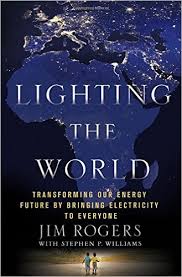Lighting the World: Transforming Our Energy Future by Bringing Electricity to Everyone
- By Jim Rogers with Stephen P. Williams
- St. Martin’s Press
- 256 pp.
- Reviewed by R.W. Clark
- August 27, 2015
The former head of Duke Energy proposes powering the homes of a billion-plus people with solar.

One-sixth of the world’s people still live without electricity, and Jim Rogers, the former chairman of Duke Energy, wants this to change. Many of these people live in Africa and Asia, far from power plants and transmission lines. But Rogers believes they can light their own homes with energy from the sun.
In Lighting the World, Rogers has come full circle. After growing up in the coal fields of Kentucky, he rose to lead the nation’s largest provider of coal-fired electricity, and then used his position to champion legislation to cap carbon emissions from coal (which failed).
Environmentalists initially burned him in effigy, but later praised him for his stand against carbon. Now retired, Rogers is on a mission to bring sustainable electric power to those who have none. “We’re going to change the world,” he promises.
The writing is breezy and nontechnical. The hardships of living in an African village without lights are vividly portrayed, as are the struggles of a New York couple who abandoned their phone and computer and moved to the Andes. But Rogers warns there is a “dark side” to producing electricity. Billions in China and India now receive power, but they choke on coal dust and “personalize facemasks for their toddlers.”
Rogers opposes building coal-fired power plants to serve another 1.2 billion people, advocating instead the use of solar panels and local-distribution systems called “microgrids.” In rural areas, a single rooftop solar panel linked to a used car battery can supply a small home with enough energy for cooking and lighting. And larger panels placed on a store or church can distribute power to a small village through a microgrid of wires. The cost of solar is currently less than the main alternative, diesel generators.
The highlight of the book is its description of the “innovative suppliers” who already bring solar-power systems to Africa and Asia. Solar Sister in Africa, for example, trains women to sell, install, and operate solar panels in their own communities. Mera Gao Power in India installs and finances microgrids. Other organizations, including one founded by Rogers, distribute LED lights, solar lanterns with cell phone chargers, and solar-powered irrigation pumps.
These efforts change lives; to expand them, Rogers makes several proposals that will be of interest to specialists. He addresses ownership rights, kerosene subsidies, payment methods, finance, business regulations, and even the United Nations.
To encourage local power projects, for example, he proposes that private utility companies be created apart from the state-owned electric monopoly. “Intractable bureaucracies” will oppose [me], he says. Maybe so, but privatization and regulatory reform are already spreading in Africa and have begun to attract new energy investment.
Lighting the World plays down the role of renewables other than solar. Africa has world-class resources of wind, geothermal, and hydropower, and projects to develop them are sprouting up from Ethiopia to South Africa, according to the Economist magazine. But you will not read about them in this book. And Latin America, which relies heavily on hydro, is treated as an afterthought.
This approach can be confusing. Consider the nation of Rwanda, where electric service is scarce but hydro and methane resources are plentiful. Should it use solar power, hydropower, methane gas, or all three?
The opening chapter, “A Vision of What Will Be,” foresees that Rwanda will do an “amazing job” of developing all of them. But later we are told solar is the best option. There is “not enough money for dams,” and if methane gas becomes cheap, “who is going to bother with solar and wind?”
The future of solar power is apparently less bright in the United States. Africa can develop a solar economy from scratch, notes Rogers, but “we have the larger hurdle of dismantling our previous industrial grid and replacing it.”
Moreover, our system depends on power plants that burn fossil fuels. Solar (and wind) cannot fully replace fossil fuels until we find a way to provide the power 24 hours a day, seven days a week. An interesting chapter reviews current energy research (imagine a doughnut-shaped “wind kite”), but finds no “silver bullets.” Unfortunately, the book does not discuss recent comments by engineers from Google and elsewhere questioning the cost and utility of relying on solar.
Overall, Lighting the World is an easy read about the future of solar power in Africa, Asia, and beyond, which will be of interest to both general audiences and specialists.
Bob Clark practiced energy law in Washington, DC, and is a past chair of the Section of Natural Resources, Energy, and Environmental Law of the American Bar Association.

